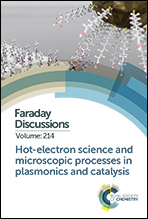Hot electron science in plasmonics and catalysis: what we argue about
Abstract
Hot electron photochemistry has made strong claims for improved control of chemical reactions. Here I discuss these claims in the light of a plethora of model experiments and theories, asking what are the key issues to solve. I particularly highlight the need to understand nanoscale thermal hot-spots, thermal gradients, and thermal transport, as well as the conventional optical confinement in plasmonics. I note how the ‘direct electron transfer’ process seems to dominate, and resembles well known ‘indirect excitons’ in semiconductor quantum wells. I believe a crucial advance still required is a prototype nano-confined geometry which allows reactants and products to access a well-controlled metallic atomic surface.

- This article is part of the themed collection: Hot-electron science and microscopic processes in plasmonics and catalysis


 Please wait while we load your content...
Please wait while we load your content...